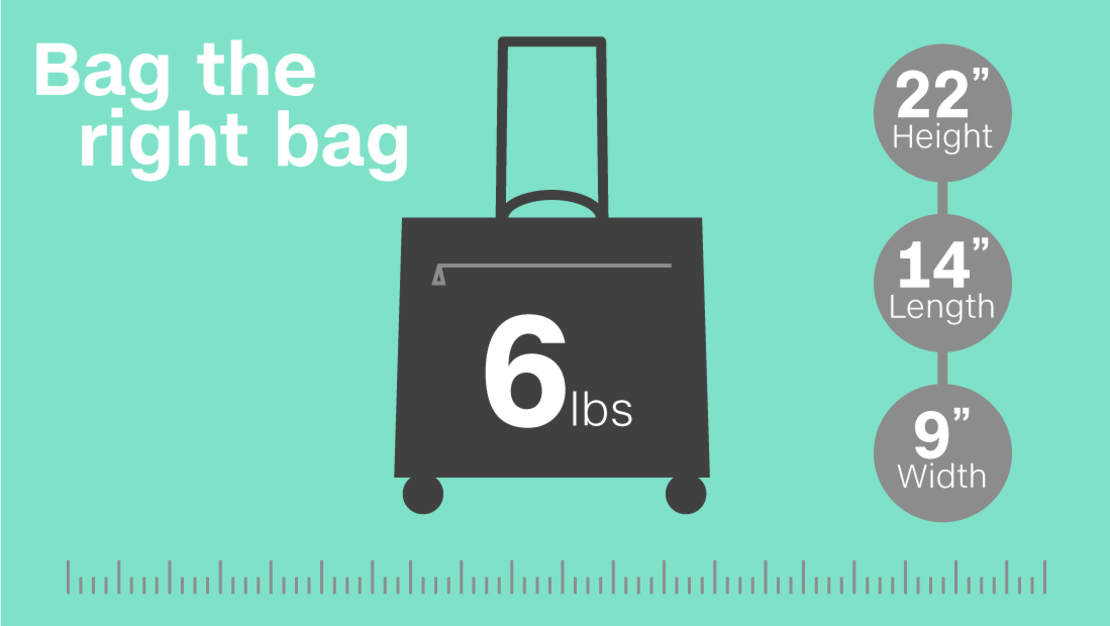Choosing the right suitcase can be a travel adventure in itself. Packing it properly with just the right contents is an art form.
Get it right and the journey to your destination will be a joy of lightened luggage containing just the right outfits. Get it wrong and it’ll be a misery of excess baggage charges, strained back muscles and cursing at the bewildering logic that led you to pack 17 pairs of shoes for a barefoot beach trip.
There are a basic set of lessons to packing like a pro. Here’s a handy 10-step guide:
1. Bag the right bag

First, let’s end any debate about whether to go for a carry-on or check-in bag: Unless you really can’t travel without taking every single thing you own – plus a few extra sweaters just in case – these days taking only what fits in an overhead is the way to go.
There are two schools of thought when it comes to luggage.
Some swear by the durability of the hard shell suitcase. Others insist the extra pliability of soft side bags can prove beneficial. Either way, lightweight and thoughtful design are keys.
A bag should be light enough empty that when packed its weight is still easy enough to hoist overhead without any unnecessary toppling into the lap of the scary looking dude in seat 17D.
Bags weighing less than 6 pounds (2.7 kilograms), like Heys’ softside spinner are ideal, and those that are roomy with smart compartments like an exterior accessible laptop section for simple removal and replacement are both functional and security-line friendly.
Most importantly, luggage should err on the safe side of the standard carry-on size – in inches that means slightly under 22 x 14 x 9 (height x length x width), or 56 x 36 x 23 in centimeters, which is the most common allowable size across airlines. Many bags claim to be regulation size carry-ons and in fact aren’t, so double check dimensions before buying to avoid forced gate check.
2. Compression is key
A compression bag is one travel gadget that isn’t a gimmick. These smart space savers can mean the difference between fitting one week’s worth of clothing in a carry-on, or two.
Flight 001’s Spacepak Clothes bag can hold up to eight pairs of men’s jeans, five shirts and a sweater, and once all the air is pushed out, fit right into a carry-on.
A bonus with this bag: one side of the Spacepak is for clean clothes, the other for dirty, so you can uphold cleanliness and maintain a tightly packed case without bundled dirty duds crammed into corners.
3. Make duds do double duty

It’s possible to fit two weeks worth of clothing into a carry-on, the items just have to be carefully curated.
First, build a foundation of neutrals, such as a chambray top, jeans, white shirt and a black dress for women. For men, a navy polo, jeans, a white button down and black slacks.
Then add in pops of color – in the form of sweaters, blouses and skirts for women / blazers and collared shirts for men – for mix and match variety.
Yes, we appreciate you won’t exactly be setting the fashion world alight, but seriously, in the proud traditional culture of the country you’re headed, that on-trend fetish leather suit won’t just land you in trouble, it’ll give you a nasty heat rash.
Ten pieces of clothing can turn into 14 outfits if properly planned.
Women can achieve this by packing four bottoms, four tops, a sweater or blazer and a dress. Guys can do the same, subbing the tops for button downs and tees and the dress for shorts, weather permitting. Each article of clothing should go with any other in the collection for the double-duty dressing to work – so go easy on the denim.
4. Go sans wrinkles
Ironing at home is already a chore, so why take it on your travels?
Reduce the need by slipping suits and such into plastic dry cleaning bags.When suitcases get jostled, garments will slide around in the bag instead of settling in one spot and getting wrinkled, so clothing will be as smooth as it was when packed upon arrival.
For business travelers, adding something like the Charles Tyrwhitt Italian-woven pure wool travel suit to your wardrobe will also mean fewer wrinkles since the more tightly twisted fibers are more resistant to creasing.
5. Pack backup
If you must pack contingency items, make sure they don’t take up essential space. A lightweight but durable duffel that can be folded into a palm-sized pouch for toting and can later be filled with the snow globes, bottles of booze and unsuitable leather fetish suits one inevitably acquires abroad.
If the need for a shopping spree arises, the bag can be checked on the return journey. When fleeing freeze for warmer climates, replace hefty outerwear with stowable alternatives such as the Craghoppers CompressLite’s hooded jacket.
6. Cut the footwear

Three pairs of footwear should accommodate the needs of any trip. Pack one dress pair, one casual pair and one comfort or athletic pair, the bulkiest of which should be worn on board.
Shoes should be packed soles to the side of the case going all around the edge, leaving space in the center for clothes, or a Spacepak.
Socks, undergarments and any other requisite small goods should be stuffed into shoes to maximize space. The footwear keeps its shape and no crevice is left unaccounted for.
Bags keep shoes protected and clothes clean, but ignore the allure of pretty shoe pouches for pairs, individual ones allow for the necessary customized placement.
7. Maximize that ‘personal item’
Most airlines allow passengers on board with one carry-on plus one personal item provided it fits under the seat. Take advantage of the opportunity to stow that extra outfit that didn’t fit in the carry-on. It can double as a spare change of clothes in the event that forced gate check leads to a lost bag.
Keep the item light to avoid piercing shoulder pain when running to a gate to catch a flight or flagging a fast-moving tuk tuk.
Electronics and chargers, valuables such as jewelry and travel documents should live here so they’re close at hand and extra safe.
8. Avoid gadget glut

Gadgets galore can be cumbersome and unnecessary, especially since many now sync.
Instead of dragging along an iThis and iThat, load up storage-capable smartphones with music, movies and memos, grab some headphones and leave the rest at home.
To further ensure tech doesn’t take over, use a do-it-all charger such as the Victorinox worldwide adapter plug with USB charger that juices up mobile phones, tablets, digital cameras and laptops in Europe, North and South America, China and Australia, among other destinations.
9. Tote tailored toiletries
Now that security regulations have relegated grooming products to baggies, leave behind goods that are added luxuries.
Hotels are good for lotion, soap and shampoo, and personal items beyond that can be squeezed into travel-size to-go containers such as flexi-Go Toobs. These easy-to-load silicone tubes hold products and prevent drips while a ring on the rim lets the user designate bottle contents.
For more offbeat personal care essentials that’d bulge beyond the baggie in their regular packaging, MiiSTS offers iPhone-sized sprays for things such as sunscreen, stain remover and insect repellent.
10. Stay secure
Safety is paramount and moving about as much as travel demands can mean vital personal data and documents are susceptible to bad deeds.
That’s the rationale behind iPassport. The slim, secure passport case comes with a biometric lock and can only be opened after scanning the owner’s fingerprint, so if it happens to get lost or stolen, no identities will be stolen with it.
It also comes with RFID (Radio Frequency Identification) protection to prevent hackers from tapping into data and Bluetooth smart tethering technology so the user can sync the device with a smartphone and track it down if necessary.
Just make sure your passport is inside it before you set off. Nothing more embarrassing than swiping it open at the airport to discover that’s where you stowed your emergency snack.
Tara Donaldson is a Brooklyn-based writer and traveler. Her work has appeared in Mariner, The Huffington Post and on her personal blog, Living with the Travel Bug.







